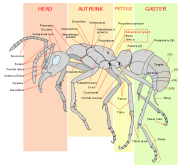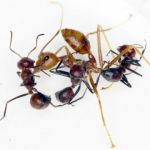Table of Contents
Ant Definition
An ant is an insect belonging to the family Formicidae. It belongs to the order Hymenoptera, together with the wasps and bees. Their distinctive features are the following: elbowed antennae and a node-like body plan. They live together in swarms, usually raising hillocks of earth, variously chambered within, where they maintain a perfect system of order, store their provisions, and nurture their young. There are many ant groups with diverse habits, examples include agricultural ants, carpenter ants, honey ants, foraging ants, and amazon ants. Termites, which are called white ants, are not ants. They belong to the order Blattodea.
Ant Features
Ants are distinguished from other insects in having the following morphological features:
• Elbowed antennae
• Metapleural glands
• Node-like petiole that forms a narrow waist between the mesosoma and the gaster
The ant body has three tagmata (body segments): head, mesosoma, and metasoma. The head contains sensory organs, such as compound eyes, three simple eyes (ocelli) that detect light, and antennae, and two strong jaws (mandibles). The mesosoma (thorax) bears the three pairs of legs and the wings when present. The legs end in a hooked claw used for climbing and hanging on to things. (Ref. 1) The metasoma (abdomen) contains the internal organs. Similar to other insects, ants have an exoskeleton that serves as a protective casing around the ant body. They respire through the spiracles, tiny valves on the exoskeleton where gasses pass through. They have an open circulatory system wherein the hemolymph (insect blood) is pumped by a dorsal aorta (acts as the heart), driving the circulation. Some ants may have a sting to inject venom against their enemies. Others have a spray acid that they release from an opening at the tip of their gaster as another form of defense. (Ref. 1)

Ant Colony
Ants form colonies that vary in size and consist of castes. The ant groups present in an ant colony are as follows: ergates (worker ants), dinergates (soldier ants), aners (fertile males), and gynes (fertile females, queens). Members of the colony communicate mainly by pheromones. They release chemicals that convey a message, e.g. food resource or an intrusion. These chemical signals are picked up through their antennae. (Ref. 2)
References
-
- kazilek. (2009, September 22). Ant Anatomy | Ask A Biologist. Asu.Edu. https://askabiologist.asu.edu/explore/ant-anatomy
- kazilek. (2009, September 27). Ant Colony | Ask A Biologist. Asu.Edu. https://askabiologist.asu.edu/explore/secrets-superorganism
©BiologyOnline. Content provided and moderated by BiologyOnline Editors.

